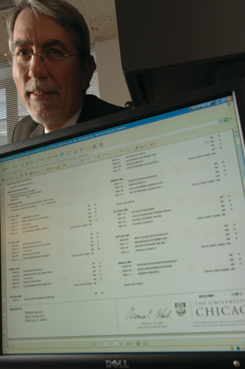Eye on the Quads
Transcripts: leaping from the 18th century to the 21st
Transcripts go high-tech.
The University of Chicago issues almost 35,000 transcripts a year at the request of students and alumni. A new service of the Office of the Registrar now offers electronic versions of these academic credentials, making Chicago only the second university in the country to do so. University Registrar Thomas Black told Jeff Bradley how this change will benefit the Chicago community.
First, how does the paper process work?
We pretty much do things the way universities did in the 18th century. When a request comes in, we reproduce the transcript on very special paper, sign it, and send it out. We used to emboss the seal—the only thing we don’t do is use sealing wax.
How does the new electronic system work?
Basically, we make a signed PDF of the transcript available through a secure server. The recipient, be it an educational institution, potential employer, or favorite uncle—whomever the alumnus wants—is notified by e-mail when the document is ready.
Diploma and transcript fraud is a billion-dollar business, so how do you keep people from changing their transcripts?
To guarantee the legitimacy of Chicago transcripts, we incorporate a “digital signature” that uses public and private key cryptography to ensure that the PDF has not been changed. This technology has been around for years and is used to guarantee the legitimacy of a wide range of documents. When a person views a Chicago transcript on a screen, a digital signature pops up and indicates whether or not the document has been changed. It would take a massive amount of computer resources to break this kind of encryption.
How long did it take to design this system?
It took us two years to develop a system in which we have complete confidence. Working with colleagues from the University’s Networking Services & Information Technologies, we conceived this unique approach. Then, with the help of corporate partners, we implemented this cutting- edge solution.
How are these brave new transcripts being received?
So far so good. This is new technology, and we’ve gotten a few calls about it, but by and large everyone wonders why we didn’t think of this before.
What are the benefits to Chicago students and alumni?
First, we save them time and money. Alumni will no longer have to supply the names and addresses of recipients. Prior to this system, if someone wanted a transcript sent overnight, the cost of shipping—which the requesting party pays—was as much as $30. If a student applied to ten graduate schools and waited until the last minute, that was serious money.
Other than saving shipping costs, what are the advantages of this new system?
Students and alumni can now manage the transcript process. Because of the University’s new ordering system, they can have an electronic transcript sent out whenever they want—even on nights, weekends, and holidays, when the office isn’t open. Even better, when the University sends out a transcript, you get an e-mail when the recipient opens it. You can call that person up five minutes later and say, “Did I get the job?”
Can students and alumni still get paper transcripts?
Yes. We will continue to provide those for the foreseeable future.
Chicago was the second university to implement this system. Who was first?
Penn State, although they were inspired by our concepts and early work in this area.
What’s next?
The sky’s the limit. There are all kinds of official documents that could be sent electronically. Anyone who has lost a passport on foreign shores and had to replace it from there would see the usefulness of this technology. By saving paper and related delivery costs, this new approach is good for the planet as well.
